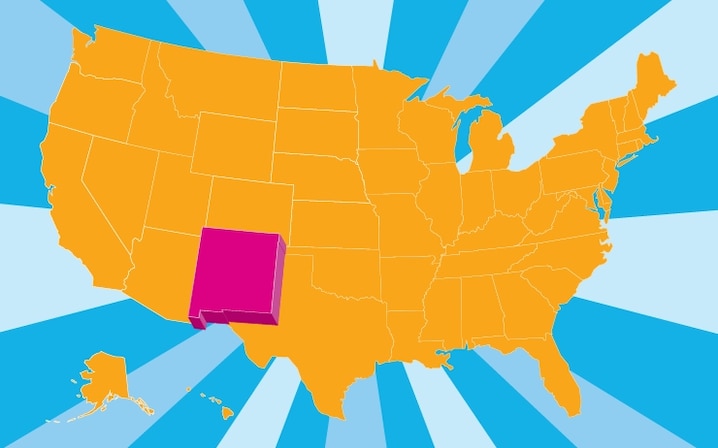# Discovering the Land of New Mexico: 10 Facts About New Mexico’s History and Landscapes
New Mexico stands as one of America’s most historically and geographically diverse states. Located in the southwestern United States, this region has a cultural heritage spanning more than 12,000 years. For travelers and history enthusiasts seeking facts about New Mexico, the state’s journey from ancient Native American settlements to Spanish colonization, and finally to U.S. statehood in 1912 provides a unique historical account unlike any other in the nation.
Among the many interesting facts about New Mexico is its unique position as a cultural crossroads where indigenous, Hispanic, and Anglo influences have blended over centuries. This state earned its nickname through its striking landscapes, from the white gypsum dunes of White Sands National Monument to the depths of Carlsbad Caverns. New Mexico’s distinctive character emerges from its natural beauty and the resilient spirit of its people who have adapted to its environments for thousands of years.

- Map of New Mexico, highlighting its distinct regions and notable geographical landmarks. Source: @NatGeo – kids.nationalgeographic.com
The human history of what’s now New Mexico stretches back an astonishing 12,000 years, beginning with early migrants who likely crossed from Asia via the Bering Strait land bridge during the last Ice Age. These ancient peoples eventually gave rise to Native American cultures, including the Apache, Zuni, Navajo, and Pueblo tribes, whose descendants still maintain their cultural traditions today. In 1540, Spanish explorer Francisco Vázquez de Coronado arrived seeking legendary cities of gold, initiating nearly three centuries of Spanish colonial rule until Mexico gained independence in 1821.
Following the Mexican-American War in 1848, New Mexico became a U.S. territory, finally achieving statehood in 1912 as the nation’s 47th state. The state received its nickname due to its diverse landscapes that seemed to attract visitors. More facts about New Mexico reveal the origin of its name – “Nueva Mexico” was coined by Spanish explorers who hoped to find treasures similar to those discovered in Mexico, though the precise etymology of “Mexico” itself remains debated among scholars.
New Mexico’s geographic diversity is notable. It occupies a location where its northwest corner creates the only spot in America where four states meet – the Four Corners Monument where New Mexico, Arizona, Utah, and Colorado converge. The state encompasses three distinct geographic regions, each with its own features. The Great Plains region stretches across eastern New Mexico with high plateaus and dramatic canyons, while the Rocky Mountain region in the north contains Wheeler Peak, the state’s highest elevation point.
In the central-southwest area lies the Basin and Range region, home to some of New Mexico’s most notable natural features. Here, the Rio Grande carves its path through the state, while nearby, the White Sands National Monument showcases the world’s largest gypsum dune field, creating a white landscape against the blue desert sky. Another remarkable feature is the Carlsbad Caverns system, comprising more than 119 limestone caves formed millions of years ago when sulfuric acid dissolved the surrounding limestone, creating massive underground chambers that continue to attract scientists and tourists.
New Mexico’s economic foundation rests significantly on its natural resources, particularly in the energy sector. The state produces substantial oil and natural gas, which account for approximately half of the state’s income from natural resources. It leads the nation in perlite production, a volcanic glass used in construction insulation and horticulture, and produces roughly three-quarters of America’s potash, an essential component in agricultural fertilizers.
The state’s ecosystems support an impressive array of wildlife, including black bears, bighorn sheep, cougars, and possibly North America’s rarest mammal – the black-footed ferret. Bird watchers can spot black vultures and scarlet tanagers, while botanists appreciate the New Mexico olive, piñon pine, and various native cacti and wildflowers named after the state. This biological diversity reflects the varied landscapes of New Mexico.
The cultural heritage of New Mexico runs deep, with indigenous traditions remaining alive. One remarkable fact is the Taos Pueblo, a Native American community that has been continuously inhabited for over a thousand years. This UNESCO World Heritage Site exemplifies the enduring indigenous presence that predates European arrival by centuries. New Mexico has also nurtured numerous creative talents, including singer John Denver, artist Georgia O’Keeffe, and even modern innovators like Amazon founder Jeff Bezos.
New Mexico’s cultural contributions extend to its art forms, particularly its turquoise jewelry traditions. Turquoise mining has deep historical roots in the region, and today, authentic New Mexico turquoise has become increasingly rare and valuable, with exceptional pieces commanding thousands of dollars. The state also embraces its position in American popular culture through attractions like the Roswell UFO Museum, which commemorates the alleged 1947 UFO crash. This blend of ancient traditions and contemporary curiosities creates a cultural landscape as diverse as the state’s natural environments.
